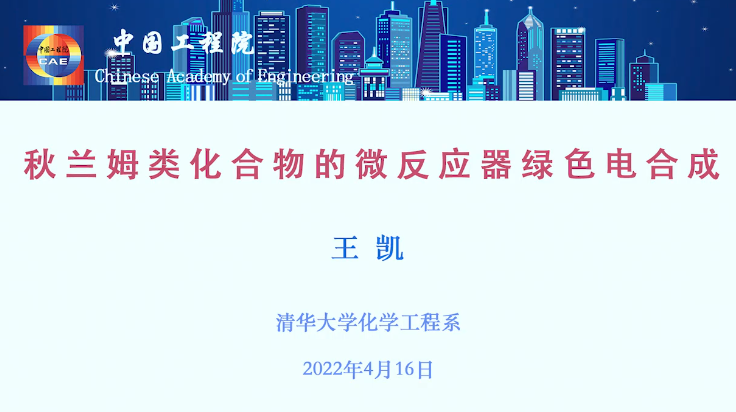检索范围:
排序: 展示方式:
Electricity-driven ammonia oxidation and acetate production in microbial electrosynthesis systems
《环境科学与工程前沿(英文)》 2022年 第16卷 第4期 doi: 10.1007/s11783-021-1476-5
• MES was constructed for simultaneous ammonia removal and acetate production.
关键词: Biocathode Carbon dioxide Electrochemical oxidation Graphite anode Boron-doped diamond
电化学微反应技术的工程研究进展——一种新型有机化合物电合成方法 Review
郑思源, 闫俊妤, 王凯
《工程(英文)》 2021年 第7卷 第1期 页码 22-32 doi: 10.1016/j.eng.2020.06.025
电化学方法环境友好,在有机化学合成中具有独特的优势。然而,传统的电化学反应器存在复杂的传递问题,限制了电化学方法的应用。近年来,微反应技术在电合成研究中的应用缩短了离子的传递距离并增加了电极的比表面积,从而促成了高效、连续且易于规模化的电合成技术。本文从过程强化的角度讨论了在电合成中使用微通道的工程优势,分析了最近报道的电化学微反应器中的流型和传质行为,并列举了反应器放大的典型例子。作为一个相对较新的研究领域,在微反应器中进行电合成的许多科学规则和工程特征都有待研究。因此本文提出了潜在的研究重点,认为其对新型电合成技术的发展至关重要。
《化学科学与工程前沿(英文)》 2022年 第16卷 第12期 页码 1761-1771 doi: 10.1007/s11705-022-2195-6
关键词: microbial electrosynthesis hydrogen evolution reaction metalloporphyrins biocompatibility CO2 conversion
Faraz Montazersadgh, Hao Zhang, Anas Alkayal, Benjamin Buckley, Ben W. Kolosz, Bing Xu, Jin Xuan
《化学科学与工程前沿(英文)》 2021年 第15卷 第1期 页码 208-219 doi: 10.1007/s11705-020-1945-6
关键词: electrosynthesis e-biofuels CO2 utilization computational model
Scale up of reactors for carbon dioxide reduction
《化学科学与工程前沿(英文)》 2023年 第17卷 第1期 页码 116-122 doi: 10.1007/s11705-022-2178-7
关键词: CO2 reduction electrochemical cell electrosynthesis upscaling
微生物电合成中链脂肪酸 Article
褚娜, 郝雯, 吴清莲, 梁勤军, 蒋永, 梁鹏, 任智勇, 曾建雄
《工程(英文)》 2022年 第16卷 第9期 页码 141-153 doi: 10.1016/j.eng.2021.03.025
微生物电合成(MES)使用微生物催化剂和电化学手段促进CO2生物转化,也应用于有机废物生物炼制。本文总结了MES 利用CO2 和有机废物产中链脂肪酸(MCFA)的研究现状与发展趋势,对传统发酵产MCFA的基本原理和研究进展进行了归纳。首先,概述了MES产MCFA的相关报道,重点介绍了多电子供体(ED)策略。其次,讨论了MES利用CO2产MCFA面临的挑战,并针对产甲烷抑制、产乙酸菌三磷酸腺苷(ATP)限制、产有机溶剂阶段提供ED有限进行了详细阐述。再次,分析了电化学手段促进有机废物生物炼制产MCFA的潜力。最后,从多级反应、底物供应、产物提取、微生物代谢路径等角度展望了未来发展方向。

H2O2的高效电合成及其电Fenton在难降解有机物降解中的应用 Article
李磊, 白晶, 江盼宇, 张岩, 周廷生, 王嘉琛, 周昌辉, 李金花, 周保学
《工程(英文)》 2023年 第30卷 第11期 页码 131-143 doi: 10.1016/j.eng.2023.02.005
O2还原反应原位电合成H2O2的利用为难降解废水的传统芬顿处理提供了一种有前景的替代方案。然而,氧气传质效率低、阴极催化剂选择性差以及电子传递动力学缓慢仍然是其主要的工程障碍。在此,我们基于新型ZrO2/CMK-3/PTFE阴极的制备,提出了一种系统解决方案,旨在高效电合成H2O2并将其应用于电芬顿降解难降解有机物。采用聚四氟乙烯作为疏水改性剂以增强电极的O2传质,采用ZrO2对电极进行亲水改性以增强O2还原的选择性及电子传递,采用介孔碳CMK-3作为催化剂基底以提供催化活性位点。此外,还设计了一O2扩散室,以强化O2从疏水层向亲水层与反应界面的接触。研究结果表明,与相同条件下的传统气体扩散阴极相比,所制备的ZrO2/CMK-3/PTFE阴极的H2O2产率提高了约7.56倍。在−1.3 V vs. SHE(对应的电流密度为−252 mA·cm−2),H2O2的产率和法拉第效率分别高达125.98 mg·cm−2·h−1 (5674.04 mmol·g−1·h−1)和78.24%。高的H2O2产率确保了系统中充足的•OH产生,进而实现了优异的电芬顿性能,使难降解有机物的降解效率超过96%。这项研究基于原位高效电合成H2O2,为利用电芬顿技术高效处理难降解废水提供了一种新颖的工程解决方案。
标题 作者 时间 类型 操作
Electricity-driven ammonia oxidation and acetate production in microbial electrosynthesis systems
期刊论文
triazine-based frameworks with excellent biocompatibility for conversion of CO in H-mediated microbial electrosynthesis
期刊论文
Electrolytic cell engineering and device optimization for electrosynthesis of e-biofuels via co-valorisation
Faraz Montazersadgh, Hao Zhang, Anas Alkayal, Benjamin Buckley, Ben W. Kolosz, Bing Xu, Jin Xuan
期刊论文
王凯:秋兰姆类化合物的微反应器绿色电合成(2022年4月16日)
2022年06月09日
会议视频








